| |
 
ANCIENT
BRIDGES OF THE ROTHER VALLEY
| The West Sussex
Rother rises near Selborne and flows from
west to east through a wide, shallow
valley, eventually joining the Arun near
Pulborough. The valley is characterised
by large arable fields, narrow sunken
lanes and scattered sandstone villages. For much of its tranquil
passage it shares the valley with the
main Petersfield - Midhurst road, which
crosses the river at Trotton. Trotton
Bridge, now guarded by traffic signals,
is just one of six ancient bridges, which
are a unique feature of the river between
Petersfield and Midhurst.
|
As it enters
Sussex just east of Petersfield, the
river passes close by where Durford Abbey
once stood. Founded by Premonstratensian
Canons during the reign of Henry II, the
Abbey met with mixed fortunes prior to
its dissolution. At one time it is said
that its nine monks had an income of
almost £100,000 each year, but by the
time it was dissolved in 1537 the
monastery was described as being
“far in debt and in great
decay.”
Little remains today, but two bridges
close by were built in the early
fifteenth century and would have
witnessed the comings and goings from the
monastery. |
|
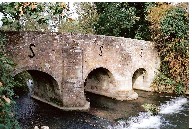 |
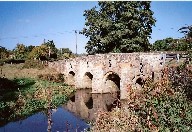 |
|
Durford Bridge,
spanning a lane opposite Durleighmarsh
Farm, is probably the least altered of
all the Rother Valley bridges, with four
round headed ribbed arches and massive
cutwaters. Further east, adjoining a
dangerous bend in the Rogate - Harting
road, we pass over Haben Bridge, which is
of similar construction, but has five
arches. Three have been repaired, and the
parapet is very vulnerable to modern
traffic.
The oldest, best known, and in many ways
the most spectacular of these bridges is
at Trotton, with its traffic lights and
heavy main road traffic. |
| It was built about
1400 by Thomas, the first Lord Camoys, a
soldier and diplomat, who was a commander
at the Battle of Agincourt in 1415 and
was appointed Knight of the Garter a year
earlier. He held the Manor of Trotton,
and owned other land in Sussex,
Hampshire, Northants, Yorkshire and
Bedfordshire. His magnificent brass, in
which he is shown in full armour holding
the hand of his second wife, Elisabeth
Mortimer, adorns the table tomb in front
of the altar in Trotton Church to this
day.
|
|
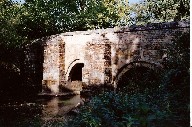 |
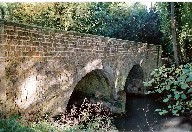 |
|
Close by is the
insignificant twin arched bridge at
Chithurst, set deep in an almost Pre-
Raphaelite wooded dell below an ancient
mound supporting the 11th century church.
Like so many villages in Sussex,
Chithurst once had its Mummers’
Play, which was performed regularly at
Christmas up until the First World War.
Since 1981 it has been the home of a
Buddhist Monastery.
Between here and Midhurst there are three
ancient villages, each with its own
bridge. |
First comes Iping,
where the Mill, just west of the five
arched bridge, was valued at 3s 4d in the
Domesday Book. During the Middle Ages it
was a fulling mill, processing cloth made
from wool, and by 1665 there was a water
mill containing a wheat mill and a malt
mill under the same roof. During the 18th
century it became a paper mill, remaining
in use for the same purpose until 1930,
when it burnt down.
Next is Stedham, where the long street
leads down to the river. The bridge, west
of the Hall, is largely 17th century, and
has six low semi-circular arches, the
southern three built of stone and the
northern three of brick. There are
V-shaped cutwaters on the west side, but
to the east are modern square buttresses |
|
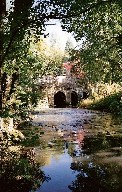 |
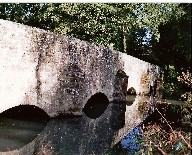 |
|
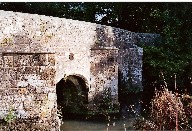 |
|
Finally,
Woolbeding, another Domesday Book
village, recorded as having a mill,
twenty-three acres of meadows and a
church. The bridge, with its huge
cutwaters, lies outside the village to
the south, and is one of the earliest of
the group, dating from the 15th or 16th
centuries, though it was repaired in
1919.
And so the Rother reaches Midhurst. What
stories could these seven bridges tell?
From pack horse to juggernaut, they have
seen them all and carried them all. |
What credit should go to
those mediaeval masons who constructed many of
them, humble, yet skilled craftsmen who could
never have envisaged what the centuries had in
store.
Tom Muckley, February 2004
This article was originally
published by the
Petersfield Post
tommuckley.co.uk
|
|








